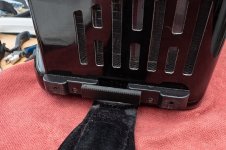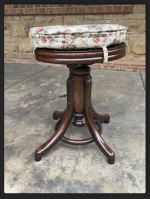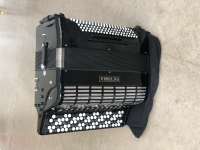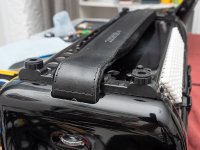HisNoodliness
Newbie
Hi all. Thanks for helping. I am a newbie in this art. I recently got myself a CBA. I've entertained this fantasy for a long time, but only made up my mind a week ago. I've been enjoying learning to play it. It's a great fun. Information from this forum was a great help to get me started.
But I ran into an issue I can't debug by myself. I can't stop my left hand from slipping under certain situations. I have uploaded a few pictures to show the left strap, as well as me playing Cmaj vs Cmin, to illustrate my specific issue.
The first two pictures illustrate the left strap. It's leather on the outside. But the inside is all velvet. I find my palm sticking to the bass board surface 20 times more than the back of my hand can ever stick to the velvet surface of the strap. I can't find a strap tightness setting that stops the back of my left hand from slipping, while allowing me to unglue my palm from the board to move between positions.
The second pair of pictures illustrate me playing Cmaj. I've learned to arch my hand to stretch the strap taut, as I see people do. But I need to tighten the strap almost all the way down to the tightest that the screw allows. But then I can barely move between positions. Here I am showing a particular tricky playing condition, where I am squeezing the bellows, and tilting the bass section as shown. In this position, the bass section tends to want to drop downward until it is parallel to the treble section. I can barely hold the bass section in place while playing Cmaj.
The third pair of pictures illustrate me playing Cmin, while squeezing the bellows. While it's just one button different from Cmaj, I can't hold the bass section in place no matter what I try, when playing Cmin. I am unable to arch my palm enough to keep enough tension on the strap to hold it. I can't actually tighten the strap anymore than it already is.
What can I do to overcome this obstacle? It's making it very hard for me to practice bass.
Thanks
Fred
But I ran into an issue I can't debug by myself. I can't stop my left hand from slipping under certain situations. I have uploaded a few pictures to show the left strap, as well as me playing Cmaj vs Cmin, to illustrate my specific issue.
The first two pictures illustrate the left strap. It's leather on the outside. But the inside is all velvet. I find my palm sticking to the bass board surface 20 times more than the back of my hand can ever stick to the velvet surface of the strap. I can't find a strap tightness setting that stops the back of my left hand from slipping, while allowing me to unglue my palm from the board to move between positions.
The second pair of pictures illustrate me playing Cmaj. I've learned to arch my hand to stretch the strap taut, as I see people do. But I need to tighten the strap almost all the way down to the tightest that the screw allows. But then I can barely move between positions. Here I am showing a particular tricky playing condition, where I am squeezing the bellows, and tilting the bass section as shown. In this position, the bass section tends to want to drop downward until it is parallel to the treble section. I can barely hold the bass section in place while playing Cmaj.
The third pair of pictures illustrate me playing Cmin, while squeezing the bellows. While it's just one button different from Cmaj, I can't hold the bass section in place no matter what I try, when playing Cmin. I am unable to arch my palm enough to keep enough tension on the strap to hold it. I can't actually tighten the strap anymore than it already is.
What can I do to overcome this obstacle? It's making it very hard for me to practice bass.
Thanks
Fred
Attachments
-
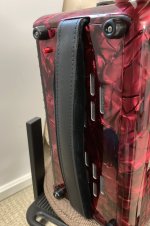 CBA left strap issue-01-leather strap-outside-IMG_3672.jpg223.7 KB · Views: 13
CBA left strap issue-01-leather strap-outside-IMG_3672.jpg223.7 KB · Views: 13 -
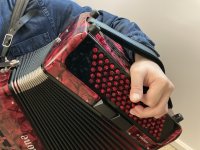 CBA left strap issue-06-hand slips playing Cmin-view 2-IMG_3678.jpg316 KB · Views: 17
CBA left strap issue-06-hand slips playing Cmin-view 2-IMG_3678.jpg316 KB · Views: 17 -
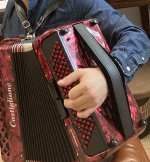 CBA left strap issue-05-hand slips playing Cmin-view 1-IMG_3672.jpg890.6 KB · Views: 14
CBA left strap issue-05-hand slips playing Cmin-view 1-IMG_3672.jpg890.6 KB · Views: 14 -
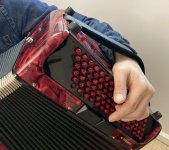 CBA left strap issue-04-hand remains firm playing Cmaj-view 2-IMG_3681.jpg339.4 KB · Views: 14
CBA left strap issue-04-hand remains firm playing Cmaj-view 2-IMG_3681.jpg339.4 KB · Views: 14 -
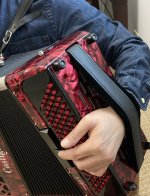 CBA left strap issue-03-hand remains firm playing Cmaj-view 1-IMG_3682.jpg363.1 KB · Views: 13
CBA left strap issue-03-hand remains firm playing Cmaj-view 1-IMG_3682.jpg363.1 KB · Views: 13 -
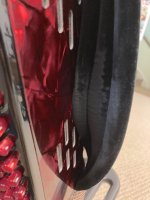 CBA left strap issue-02-leather strap-inside velvet.jpg295.3 KB · Views: 13
CBA left strap issue-02-leather strap-inside velvet.jpg295.3 KB · Views: 13

